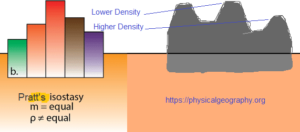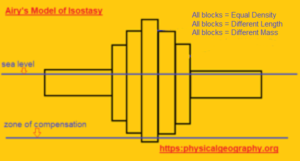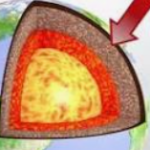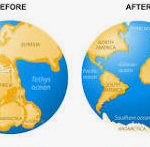Isostasy
C.E Dutton, in 1889, suggested that a gravitational balance exists between the elevated masses (i.e. continents) and ocean basin of the earth’s crust. It is believed that the lithosphere floats on the top of the partially molten substratum (asthenosphere) much like logs float on water. Mountains stand high because they are composed of rocks of low density, and ocean basins are low because they are made up of rocks of higher density. This gravitational balance of the floating lithosphere is called “isostasy”.
In the isostatic adjustment, mainly vertical movement of the crustal blocks takes place. For example, when the material is removed from the top of a mountain by erosion, it rises upwards and when sediments derived from it accumulate in a depositional basin, it is depressed due to increased weight.
Zone of Compensation
At depths between 96 and 200 kilometers below the surface, the rocks exist in a plastic state. Here pressures due to elevated masses and depressed areas are equal. This zone is called the “zone of compensation”.
In the 19th century, while doing the trigonometrical survey, it was found that the deflection of the plumb line toward the Himalayas was not proportional to the gravitational attraction of the mass of the mountain range. It was much less than the estimated value. As a result in 1855, both J.H. Pratt and G.B. Airy proposed that the continents consist of lighter material floating on denser substratum.
Pratt’s Hypothesis
Pratt suggested that the different heights of mountains were due to blocks of different densities floating at the same base level. This idea can be illustrated with the help of the following figure. Blocks of metals having different densities are immersed in the mercury. They have equal weights, and cross-sections but different lengths. These blocks sink to the same level in the mercury but their upper surface stands out at different heights. The lighter the block, the higher it stands. Here the longer blocks represent mountains and the lower blocks are ocean basins.

Airy’s Hypothesis
Airy considered that the different heights of land masses were due to blocks of different thicknesses and the same density floating at different depths. The following figure illustrates Airy’s hypothesis. Here all the blocks are of the same material, but they have different lengths. The bases of the blocks will not be even, and their tops will also be irregular. The high columns will have deep extensions downward and the low columns will have short ones, therefore, the level of compensation will be uneven.

The basis of the model is Pascal’s law, and particularly its consequence that, within a fluid in static equilibrium, the hydrostatic pressure is the same on every point at the same elevation (surface of hydrostatic compensation):

Today Airy’s hypothesis is generally accepted as it explains very well the following features.
- The mountains which are composed of light material have deep roots extending into the mantle. The existence of these roots has been confirmed by seismic and gravitational data.
- The thickness of sial under plains near sea level is only about 30 km.
- Beneath the oceans the sial layer is absent altogether and the crus is thinner than that of the continents.
The Vening Meinesz, or flexural isostasy model
The Vening Meinesz-Moritz (VMM) inverse problem of isostasy has been developed and applied successfully in different areas over the globe. In this theory, a mean isostatic compensation depth, as well as a density contrast between the crust and mantle, is considered for modeling the Moho undulation in such a way that the isostatic gravity anomaly vanishes.
This hypothesis was suggested to explain how large topographic loads such as seamounts (e.g. Hawaiian Islands) could be compensated by regional rather than local displacement of the lithosphere. This is the more general solution for lithospheric flexure, as it approaches the locally compensated models above as the load becomes much larger than a flexural wavelength or the flexural rigidity of the lithosphere approaches zero.
In other words, the differences between the attractions of the compensating masses underneath the topographic/bathymetric (TB) masses should be equal to the gravity anomaly. Isostasy of the Vening Meinesz type deals with the regional compensations of the TB loads rather than the local ones. For example, the vertical displacement z of a region of ocean crust would be described by the differential equation.

However, considering only two parameters of mean compensation depth and density contrast seems to be insufficient to have the regional compensation from the hydrostatic theory of isostasy. Therefore, it is necessary to study this method further and compare it with the flexural isostasy, which has the regional compensation mechanism inherently, and investigate how much the VMM and flexural models agree.
Level of compensation
The level of compensation (also known as the compensation level, or compensation depth) is the depth below which the pressure is identical across any horizontal surface. In stable regions, it lies in the deep crust, but in active regions, it may lie below the base of the lithosphere. In the Pratt model, it is the depth below which all rock has the same density; above this depth, density is lower where topographic elevation is greater.
Evidence of Isostasy
If the isostatic theory is correct, we would expect that if weight is added to the crust, it will respond by subsiding and when weight is removed, there will be uplifting. Evidence of this type exists.
- Parts of Norway and Sweden which were covered by the thick Pleistocene ice sheets, are rising following the melting of the ice.
- When erosion strips off the tops of the mountains, the mountains themselves rise upward. The process of uplifting and erosion continues until the roots of the mountain reach the same height as the surrounding crust.
You may like:


Leave a Reply